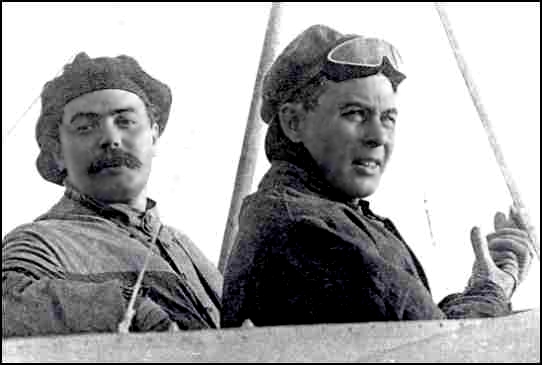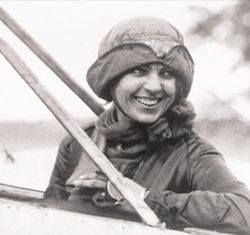
John Bevins Moisant, a pioneer United States aviator, was never without his beloved tabby cat, Paris-London. Even when performing aerial maneuvers over cities or racing his Blériot monoplane around the Statue of Liberty, Paris-London was always at his side. Hence, the daredevil pilot earned the nickname of Captain Kitty.
According to reports, Paris-London traveled on 14 documented flights–she even joined Moisant and his mechanic, Albert Fileux, when Moisant flew the first flight with a passenger (or should I say passengers?) across the English Channel on August 23, 1910. Following this flight, the co-pilot reportedly meowed happily for the photographers in London.

John Moisant adored his cat, and did everything possible to make her comfortable in flight. Apparently she shredded the leather seats on her first five flights, so the doting owner wrapped the seats with sisal rope for her to scratch. When she was just a tiny kitten, she flew while sleeping inside his coat pocket.
He also secured her litter box to the floor in front of the passenger’s seat. The box was never moved to make room for passengers–they simply had to deal with the fact that Paris-London was always the co-pilot. Rumor has it that Paris-London actually used the litter box while undergoing multiple “gees” (gravity forces), but I can’t prove that.

The Race Around the Statue of Liberty
On October 30, 1910, an estimated 150,000 people flocked to Belmont Park on Long Island to watch Moisant and other pilots perform aerial maneuvers and compete in a race to the Statue of Liberty. According to one newspaper report, “fully one million persons in all neighborhoods of the city” were on the streets waiting for the race to pass overhead.
Much to the delight of the spectators at Belmont Park, Moisant won the race with the fastest time: 34 minutes and 38 seconds. Unfortunately, the outcome of the race was challenged by another pilot, and Moisant was disqualified on a technical issue.

On December 30, 1910, John Moisant was making a preparatory flight for a competition in Kenner, Louisiana, when his aircraft got caught in a gust of wind. Moisant attempted to land, but was catapulted from the plane (he refused to wear a seatbelt) as it up-ended and nose-dived from an altitude of about 100 feet into a field.

John Moisant was rushed by special train to Charity Hospital in New Orleans, but he was pronounced dead on arrival.
Ironically, some people on Captain Kitty’s flying team had become quite concerned with his increasing recklessness in the air. Business manager Albert Levino told him to be more cautious, to which Moisant reportedly replied, “I don’t expect to die in an airplane flight.”
As for Paris-London, she reportedly continued flying with John Moisant’s sister, Matilde Moisant, who trained to become a pilot at the Moisant Aviation School on Long Island.

Today, a popular tribute to Moisant can still be found on luggage tags in the Louis Armstrong New Orleans International Airport baggage claim area. That’s because the airport still retains its “MSY” identifier, which is an abbreviation for Moisant Stock Yards, the name given to the cattle stock yards where Moisant’s fatal crash occurred, and upon which the airport was later built.
The Moisant International Aviators and Harriet Quimby
Just two months before his untimely death, a group of eight death-defying aviators were recruited by Moisant and his older brother, Alfred, to go barnstorming across America.
The wandering troupe, which also included roustabouts, ticket sellers, press agents, and mechanics, traveled by special train out of New York, and made stops in numerous cities across the country.
When the tour disbanded early in 1911, Alfred Moisant returned to New York and opened an aviation school at Hempstead Plains, Long Island. One of the school’s first students was 36-year-old Harriet Quimby, who was awarded a U.S. pilot’s certificate by the Aero Club of America, becoming the first certified female pilot in the country.
The following month, on September 4, 1911, Harriet Quimby became the first woman to make a night flight. She made this flight by the light of the moon in the presence of an estimated 20,000 spectators at the Richmond County Fair Grounds, then located at Richmond Terrace and Belmont Avenue in West New Brighton, Staten Island.

On July 1, 1912, while flying with event organizer William Willard at the Third Annual Boston Aviation Meet, Quimby’s aircraft unexpectedly pitched forward, tossing both Quimby and Willard from the plane from an altitude of about 1,500 feet.
Quimby was buried in the Woodlawn Cemetery in the Bronx. The following year, her remains were moved to the Kensico Cemetery in Valhalla, New York.
If you enjoyed this cat story, you may also like the story of Trent, the famous mascot cat of the airship, America.


